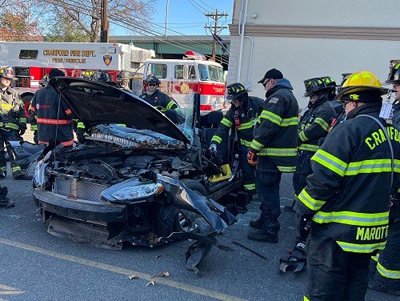Driving can be daunting, but when drivers in eastern New Jersey have an accident, they can rely on the community’s first responders to have the latest guidance on rescuing accident victims from a late-model vehicle with numerous airbags, advanced technology or electric/hybrid engines.
Benner’s Auto Body, located at 606 S. Ave E, Cranford Township, NJ, hosted first responders from the Cranford and Westfield fire departments at a special National Auto Body Council® First Responder Emergency Education (F.R.E.E.™) program Nov. 19, to help ensure New Jersey drivers have the best prepared response in case of an accident.
“We always want to help drivers in our area be safer on the road, and helping ensure that first responders are ready with the rescue skills needed for today’s vehicles is just one important way of doing that,” said Joe O’Neil, owner of Benner’s Auto Body. “With all of the airbags, advanced technology and electric batteries in vehicles today, it is challenging for first responders to get the information and education they need to rescue accident victims.
"By partnering with GEICO to donate the vehicles and Genesis to provide the tools and education, we can give our local first responders the guidance they need to rescue local accident victims more quickly," O'Neil said. "We’re proud to support our Cranford and Westfield fire departments with this program.”
The NABC F.R.E.E. program helps prepare local first responder teams to rescue accident victims from these late-model vehicles. The program provides education and live demonstrations on working with high-strength steel, airbags, advanced restraint systems, onboard technology and safety around alternative fuel vehicles.
The growing popularity of high-voltage hybrid and electric vehicles and the many safety concerns surrounding these vehicles makes this program a necessity. Alternative fuel systems present different challenges when first responders arrive at the scene of an accident. Electric cars, hybrid cars and natural gas vehicles have fuel systems that pose dangers for first responders if need arises to “cut” the vehicle for rescue.
Source: NABC










Abby Andrews